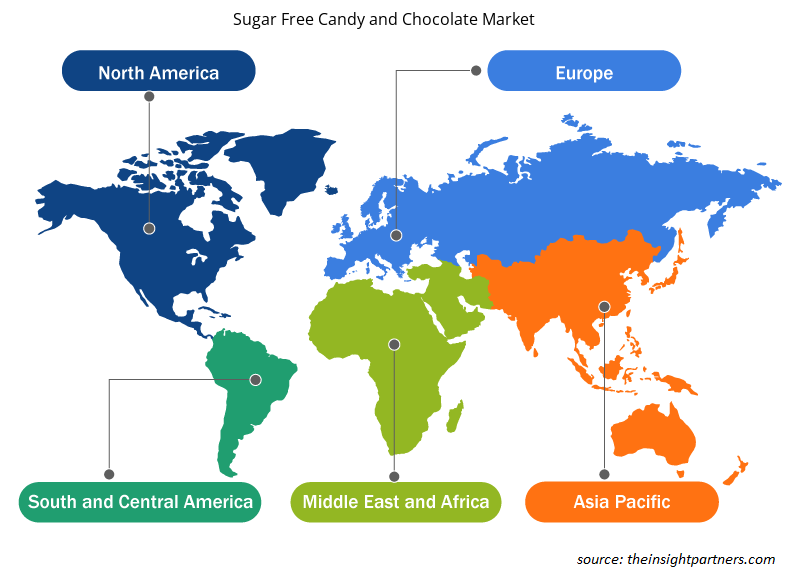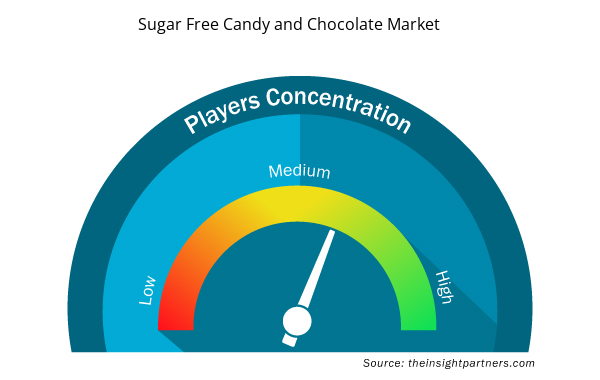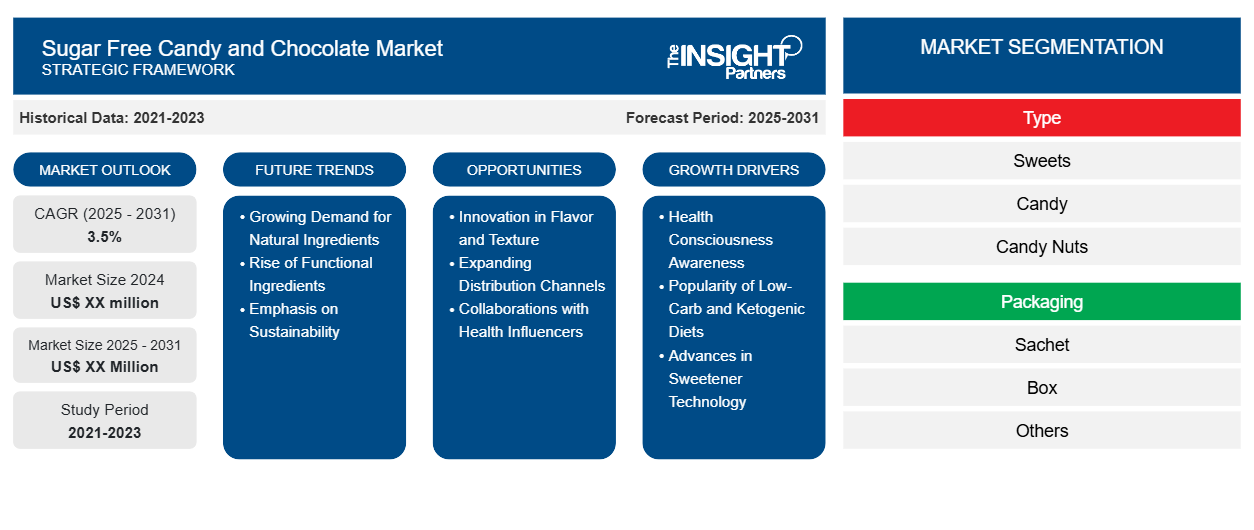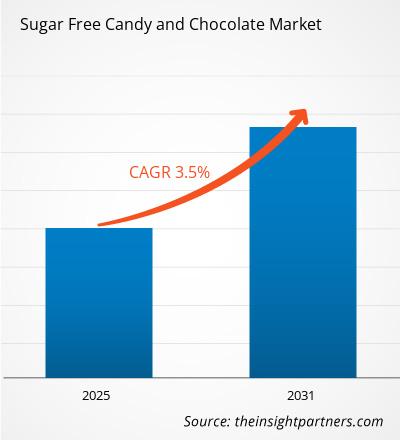The Sugar Free Candy and Chocolate Market is expected to register a CAGR of 3.5% from 2023 to 2031, with a market size expanding from US$ XX million in 2023 to US$ XX Million by 2031.
The report is segmented by type (sweets, candy, candy nuts, chocolates, chewing gum, others) and packaging (sachet, box, others). The report further presents analysis based on distribution channel (store-based, non-store based). The global analysis is further broken-down at regional level and major countries. The Report Offers the Value in USD for the above analysis and segments.
Purpose of the Report
The report Sugar Free Candy and Chocolate Market by The Insight Partners aims to describe the present landscape and future growth, top driving factors, challenges, and opportunities. This will provide insights to various business stakeholders, such as:
- Technology Providers/Manufacturers: To understand the evolving market dynamics and know the potential growth opportunities, enabling them to make informed strategic decisions.
- Investors: To conduct a comprehensive trend analysis regarding the market growth rate, market financial projections, and opportunities that exist across the value chain.
- Regulatory bodies: To regulate policies and police activities in the market with the aim of minimizing abuse, preserving investor trust and confidence, and upholding the integrity and stability of the market.
Sugar Free Candy and Chocolate Market Segmentation
Type
- Sweets
- Candy
- Candy Nuts
- Chocolates
- Chewing Gum
- Others
Packaging
- Sachet
- Box
- Others
Distribution Channel
- Store-based
- Non-store Based
Geography
- North America
- Europe
- Asia-Pacific
- South and Central America
- Middle East and Africa
Geography
- North America
- Europe
- Asia-Pacific
- South and Central America
- Middle East and Africa
Customize This Report To Suit Your Requirement
You will get customization on any report - free of charge - including parts of this report, or country-level analysis, Excel Data pack, as well as avail great offers and discounts for start-ups & universities
- Get Top Key Market Trends of this report.This FREE sample will include data analysis, ranging from market trends to estimates and forecasts.
Sugar Free Candy and Chocolate Market Growth Drivers
- Health Consciousness Awareness: The main driver of the sugar-free candies and chocolates market is health consciousness awareness, as the concerns of consumers about health are increasingly on the increase. With more becoming conscious of the poor health effects associated with sugar, including obesity and diabetes, a more expansive level of demand for sugar-free alternatives is witnessed. This shift among consumers forces manufacturers to develop a far wider range of sugar-free products tailored for health-conscious people.
- Popularity of Low-Carb and Ketogenic Diets: The other major driver is the soaring popularity of low-carb and ketogenic diets. These diets normally control sugar intake while offering freedom to indulge in favorite treats. Consumers on these diets are searching for attractive products, and sugar-free candies and chocolates become an attractive answer that also meets the dietary requirements but need not compromise on taste.
- Advances in Sweetener Technology: Advances in sweetener technology have also catalyzed the growth of the sugar-free market. High-quality natural sweeteners like stevia and monk fruit help manufacturers to create candies and chocolates that taste great but are low in calories. This innovation appeals not only to health-conscious consumers but also to brands looking to differentiate themselves in a crowded marketplace.
Sugar Free Candy and Chocolate Market Future Trends
- Growing Demand for Natural Ingredients: The future of the sugar-free candies and chocolates market is likely to see a growing emphasis on natural and clean-label ingredients. As consumers become more discerning about their food choices, there will be increased demand for products made with natural sweeteners and minimal processing. Brands that prioritize transparency in ingredient sourcing and formulation will likely resonate with health-conscious consumers seeking guilt-free indulgence.
- Rise of Functional Ingredients: Another emerging trend is the incorporation of functional ingredients into sugar-free candies and chocolates. Products fortified with vitamins, minerals, and superfoods are gaining popularity as consumers look for treats that offer additional health benefits. This innovation allows manufacturers to position their offerings as not just indulgent snacks but also as part of a balanced, health-focused lifestyle.
- Emphasis on Sustainability: Sustainability will also play a critical role in shaping future market trends. As environmental awareness grows, consumers are increasingly seeking brands that adopt eco-friendly practices, from sustainable sourcing to minimal packaging. Companies that commit to sustainability initiatives and communicate these efforts effectively will likely enhance their appeal and foster consumer loyalty in a competitive landscape.
Sugar Free Candy and Chocolate Market Opportunities
- Innovation in Flavor and Texture: Products under this category, sugar-free candies and chocolates, can be seen to provide ample opportunities for innovation in terms of new flavors and textures. With the consumers seeking diversity and fun for snacking, the makers are open to unique flavor and ingredient combinations, which would go a long way in attracting health-conscious consumers seeking alternative, tasty experiences without compromising on the taste.
- Expanding Distribution Channels: Another promising avenue would be through the expansion of distribution channels, especially e-commerce market platforms. As online shopping gains widespread traction, improved digital presence with easy purchase options opens further avenues for brands to reach a wider swath of consumers. Online marketing strategies can be targeted at specific demographics to create awareness and sales to increase consumer accessibility of sugar-free candies and chocolates.
- Collaborations with Health Influencers: A partnership with health and wellness influencers may be a good and fresh ground for growth. Brands can provide value through the representation of trusted figures in the nutrition and fitness space, ensuring they give the right message about sugar-free products and are credible. This approach not only increases the brand's visibility but also influences trial and adoption among consumers looking to have healthier snack alternatives.
Sugar Free Candy and Chocolate Market Regional Insights
The regional trends and factors influencing the Sugar Free Candy and Chocolate Market throughout the forecast period have been thoroughly explained by the analysts at Insight Partners. This section also discusses Sugar Free Candy and Chocolate Market segments and geography across North America, Europe, Asia Pacific, Middle East and Africa, and South and Central America.

- Get the Regional Specific Data for Sugar Free Candy and Chocolate Market
Sugar Free Candy and Chocolate Market Report Scope
| Report Attribute | Details |
|---|---|
| Market size in 2023 | US$ XX million |
| Market Size by 2031 | US$ XX Million |
| Global CAGR (2023 - 2031) | 3.5% |
| Historical Data | 2021-2022 |
| Forecast period | 2024-2031 |
| Segments Covered | By Type
|
| Regions and Countries Covered | North America
|
| Market leaders and key company profiles |
|
Sugar Free Candy and Chocolate Market Players Density: Understanding Its Impact on Business Dynamics
The Sugar Free Candy and Chocolate Market market is growing rapidly, driven by increasing end-user demand due to factors such as evolving consumer preferences, technological advancements, and greater awareness of the product's benefits. As demand rises, businesses are expanding their offerings, innovating to meet consumer needs, and capitalizing on emerging trends, which further fuels market growth.
Market players density refers to the distribution of firms or companies operating within a particular market or industry. It indicates how many competitors (market players) are present in a given market space relative to its size or total market value.
Major Companies operating in the Sugar Free Candy and Chocolate Market are:
- The Hershey Company
- Nestle
- Mondelez
- Ferrero
- Meiji
Disclaimer: The companies listed above are not ranked in any particular order.

- Get the Sugar Free Candy and Chocolate Market top key players overview
Key Selling Points
- Comprehensive Coverage: The report comprehensively covers the analysis of products, services, types, and end users of the Sugar Free Candy and Chocolate Market, providing a holistic landscape.
- Expert Analysis: The report is compiled based on the in-depth understanding of industry experts and analysts.
- Up-to-date Information: The report assures business relevance due to its coverage of recent information and data trends.
- Customization Options: This report can be customized to cater to specific client requirements and suit the business strategies aptly.
The research report on the Sugar Free Candy and Chocolate Market can, therefore, help spearhead the trail of decoding and understanding the industry scenario and growth prospects. Although there can be a few valid concerns, the overall benefits of this report tend to outweigh the disadvantages.
- Análisis histórico (2 años), año base, pronóstico (7 años) con CAGR
- Análisis PEST y FODA
- Tamaño del mercado Valor/volumen: global, regional, nacional
- Industria y panorama competitivo
- Conjunto de datos de Excel



Report Coverage
Revenue forecast, Company Analysis, Industry landscape, Growth factors, and Trends

Segment Covered
This text is related
to segments covered.

Regional Scope
North America, Europe, Asia Pacific, Middle East & Africa, South & Central America

Country Scope
This text is related
to country scope.
Preguntas frecuentes
Future trends in the sugar-free candies and chocolates market include a focus on natural ingredients, the incorporation of functional additives, and a commitment to sustainability in production and packaging.
Based on type,chocolates segment is expected to witness the fastest growth during the forecast period
Based on geography, North America held the largest share of the sugar free candy and chocolate market due to the well-established food industry across the region
The Sugar Free Candy and Chocolate Market is estimated to witness a CAGR of 3.5% from 2023 to 2031
The sugar-free candies and chocolates market is driven by increasing health consciousness, the popularity of low-carb diets, and advancements in natural sweetener technology.
Mars, Incorporated; Mondelez International, Inc.; Hershey's (The Hershey Company); Nestlé S.A.; and Ferrero Group are some of the key players operating in the sugar free candy and chocolate market
Trends and growth analysis reports related to Food and Beverages : READ MORE..
1. The Hershey Company
2. Nestle
3. Mondelez
4. Ferrero
5. Meiji
6. Ezaki Glico
7. Lindt and Sprungli
8. Brach's
9. Jelly Belly
10. Dr. John's Candies
The Insight Partners performs research in 4 major stages: Data Collection & Secondary Research, Primary Research, Data Analysis and Data Triangulation & Final Review.
- Data Collection and Secondary Research:
As a market research and consulting firm operating from a decade, we have published and advised several client across the globe. First step for any study will start with an assessment of currently available data and insights from existing reports. Further, historical and current market information is collected from Investor Presentations, Annual Reports, SEC Filings, etc., and other information related to company’s performance and market positioning are gathered from Paid Databases (Factiva, Hoovers, and Reuters) and various other publications available in public domain.
Several associations trade associates, technical forums, institutes, societies and organization are accessed to gain technical as well as market related insights through their publications such as research papers, blogs and press releases related to the studies are referred to get cues about the market. Further, white papers, journals, magazines, and other news articles published in last 3 years are scrutinized and analyzed to understand the current market trends.
- Primary Research:
The primarily interview analysis comprise of data obtained from industry participants interview and answers to survey questions gathered by in-house primary team.
For primary research, interviews are conducted with industry experts/CEOs/Marketing Managers/VPs/Subject Matter Experts from both demand and supply side to get a 360-degree view of the market. The primary team conducts several interviews based on the complexity of the markets to understand the various market trends and dynamics which makes research more credible and precise.
A typical research interview fulfils the following functions:
- Provides first-hand information on the market size, market trends, growth trends, competitive landscape, and outlook
- Validates and strengthens in-house secondary research findings
- Develops the analysis team’s expertise and market understanding
Primary research involves email interactions and telephone interviews for each market, category, segment, and sub-segment across geographies. The participants who typically take part in such a process include, but are not limited to:
- Industry participants: VPs, business development managers, market intelligence managers and national sales managers
- Outside experts: Valuation experts, research analysts and key opinion leaders specializing in the electronics and semiconductor industry.
Below is the breakup of our primary respondents by company, designation, and region:

Once we receive the confirmation from primary research sources or primary respondents, we finalize the base year market estimation and forecast the data as per the macroeconomic and microeconomic factors assessed during data collection.
- Data Analysis:
Once data is validated through both secondary as well as primary respondents, we finalize the market estimations by hypothesis formulation and factor analysis at regional and country level.
- Macro-Economic Factor Analysis:
We analyse macroeconomic indicators such the gross domestic product (GDP), increase in the demand for goods and services across industries, technological advancement, regional economic growth, governmental policies, the influence of COVID-19, PEST analysis, and other aspects. This analysis aids in setting benchmarks for various nations/regions and approximating market splits. Additionally, the general trend of the aforementioned components aid in determining the market's development possibilities.
- Country Level Data:
Various factors that are especially aligned to the country are taken into account to determine the market size for a certain area and country, including the presence of vendors, such as headquarters and offices, the country's GDP, demand patterns, and industry growth. To comprehend the market dynamics for the nation, a number of growth variables, inhibitors, application areas, and current market trends are researched. The aforementioned elements aid in determining the country's overall market's growth potential.
- Company Profile:
The “Table of Contents” is formulated by listing and analyzing more than 25 - 30 companies operating in the market ecosystem across geographies. However, we profile only 10 companies as a standard practice in our syndicate reports. These 10 companies comprise leading, emerging, and regional players. Nonetheless, our analysis is not restricted to the 10 listed companies, we also analyze other companies present in the market to develop a holistic view and understand the prevailing trends. The “Company Profiles” section in the report covers key facts, business description, products & services, financial information, SWOT analysis, and key developments. The financial information presented is extracted from the annual reports and official documents of the publicly listed companies. Upon collecting the information for the sections of respective companies, we verify them via various primary sources and then compile the data in respective company profiles. The company level information helps us in deriving the base number as well as in forecasting the market size.
- Developing Base Number:
Aggregation of sales statistics (2020-2022) and macro-economic factor, and other secondary and primary research insights are utilized to arrive at base number and related market shares for 2022. The data gaps are identified in this step and relevant market data is analyzed, collected from paid primary interviews or databases. On finalizing the base year market size, forecasts are developed on the basis of macro-economic, industry and market growth factors and company level analysis.
- Data Triangulation and Final Review:
The market findings and base year market size calculations are validated from supply as well as demand side. Demand side validations are based on macro-economic factor analysis and benchmarks for respective regions and countries. In case of supply side validations, revenues of major companies are estimated (in case not available) based on industry benchmark, approximate number of employees, product portfolio, and primary interviews revenues are gathered. Further revenue from target product/service segment is assessed to avoid overshooting of market statistics. In case of heavy deviations between supply and demand side values, all thes steps are repeated to achieve synchronization.
We follow an iterative model, wherein we share our research findings with Subject Matter Experts (SME’s) and Key Opinion Leaders (KOLs) until consensus view of the market is not formulated – this model negates any drastic deviation in the opinions of experts. Only validated and universally acceptable research findings are quoted in our reports.
We have important check points that we use to validate our research findings – which we call – data triangulation, where we validate the information, we generate from secondary sources with primary interviews and then we re-validate with our internal data bases and Subject matter experts. This comprehensive model enables us to deliver high quality, reliable data in shortest possible time.


 Obtenga una muestra gratuita de este informe
Obtenga una muestra gratuita de este informe